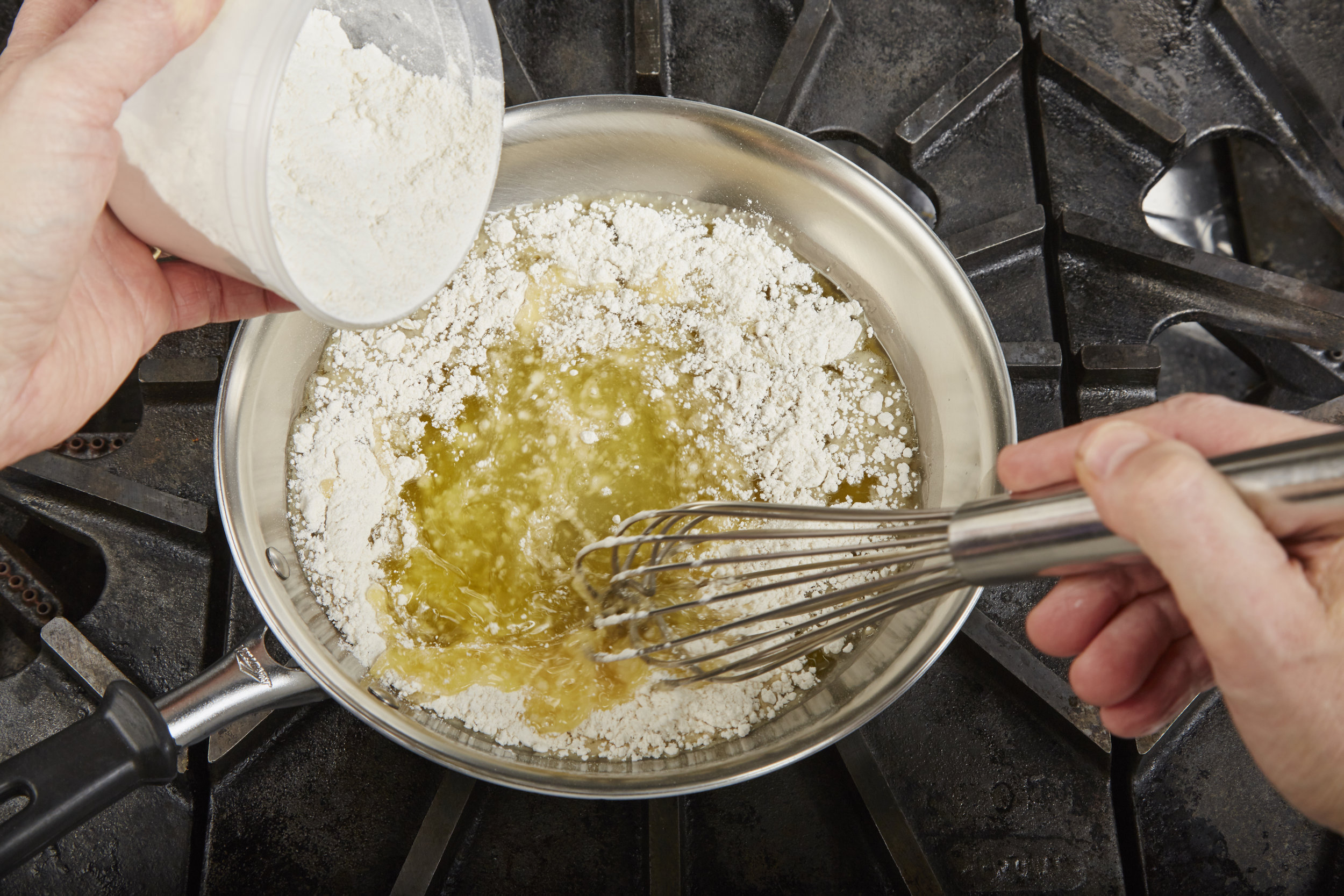About Sauces
Sauces are the pinnacle of a chef’s achievement requiring study and practice to master. A great saucier must have a discriminating palate and the ability to understand how to build depth and harmony into a sauce.
The formal study of sauces usually begins with the classic French sauces. Today, however, world influences from Asia, Latin America, Africa, and the Mediterranean, along with the public’s appetite for new and exciting tastes, have driven sauces in many different directions and brought an array of flavors and endless possibilities to their preparation and pairing.
The French term sauce is derived from the Latin salus, which means salted. Salsa is the term for sauces in Spanish and Italian. Sauces are meant to relish and complement foods and make them more interesting. They pull together different elements of a dish to complement or provide a contrast in flavors and textures. Some sauces, like a classic demi-glace, take days to prepare, while others, including vinaigrette, can be made very quickly. Sauces can be as simple as thickened pan juices or as complex as a Mexican mole or an Indian curry. Thousands of sauce variations can be created once you master the basics.
Sauce preparation used to involve a laborious and time-consuming commitment, and while this is still the case for the preparation of classic French sauces, the reality is that in today’s kitchen, very few operations prepare and use them as originally intended. These sauces have grown out of favor, including the changing preferences of chefs and the clientele they serve, the time factor involved in their preparation, and the cost of producing the sauces. In today’s world, food cost economics, the desire for workplace efficiency, and lack of skill have created convenience sauces and shortcuts that produce adequate results to time-tested methods that have evolved over centuries of practice.
History of Sauces
Records of sauces dating from around 200 AD and attributed to Apicius, an authoritative text of cooking from ancient Rome, include highly seasoned preparations containing herbs, spices, vinegar, honey, and a form of fermented fish sauce called garum. These sauces were usually prepared with a mortar and pestle and thickened with pounded rice, nuts, or bread. From Roman times to the Middle Ages, dating around the 14th century, European sauce preparation hasn’t changed much. Garum fish sauce gave way to vinegar and verjus as a flavoring, and almonds were used to thicken them. During the Crusades, exotic spices from the Middle East came into popular demand. Sometime in the 15th century, chefs learned about the benefits of reducing sauces to concentrate flavors by simmering them on the stove. They also learned about clarification and straining sauces for better texture and smoothness.
French Sauce History
Classic French sauces have evolved over hundreds of years and are organized by a standardized system that has influenced chefs and cuisines around the globe. Guillaume Tirel, also known as Taillevant (1312-1395), author of the oldest known French cookbook called “Le Viandier,” included 17 sauces and used bread, egg yolks, and vegetable purees to thicken his sauces.
One of the early icons of French cuisine, Francois Pierre de La Varennes (1618-1678), authored “Le Cuisinier Francais," which is credited as the first recorded evidence of the use of a roux to thicken sauces instead of bread. His book included recipes for Béchamel Sauce and a sauce quite similar to a Hollandaise sauce. He also incorporated the reduction of stocks to boost flavor.
The great French chef Antoine Careme (1784-1833), considered the founding father of classic French cuisine and the king of cooks, identified Espagnole, Velouté, Béchamel, and Allemande as the grande or mother sauces.
Auguste Escoffier (1846-1935), the author of "Le Guide Culinaire" and the chef credited with codifying classic French cuisine, further classified the grande sauce family as espagnole, demi-glace, Lenten espagnole, velouté, béchamel, allemande, tomato, and hollandaise. The list has been refined to espagnole, velouté, béchamel, tomato and hollandaise. Some chefs argue that espagnole is not a mother sauce because it must be refined to a demi-glace before use. Therefore, a demi-glace instead of espagnole should be listed as a mother sauce. An argument is sometimes made against hollandaise as a grande sauce because it cannot be prepared in advance like the other sauces. Because the French grande sauces were designed as base sauces intended for use in soups and small derivative sauces, they are not highly seasoned.
Classic French Sauces
World Influence of Sauces
In Western culture, the French revolutionized the preparation of sauces and methodically organized a system of uniform recipes that few other cultures could rival. These sauces established a systematic way to efficiently produce thousands of sauce and soup variations based on five grande sauces. Escoffier in Le Guide Culinaire lists almost 80 small derivative sauces based on the grande sauces.
Other European cultures established their traditions, none rivaling the grande sauces, but often borrowing the French and other world influences in their cuisine to create their regional sauce traditions. In England, gravies and natural juices from roasted meats melted butter sauces prepared with herbs and seasonings, condiments including Worcestershire, ketchup, and chutney are served alongside meats, fish, and poultry. Italy has a rich tradition of sauces that are commonly used for pasta. They include simple olive oil and garlic preparations, pesto, and tomato-based ragu or sugo. These sauces tend to be coarse and less refined than the French classics.
Asian influences from China developed fermented bean sauces, including soy sauce, hoisin, black bean, chilies, and sweet-sour combinations. Japanese cuisine uses dashi, a stock prepared with dried seaweed, bonito, mushrooms, or fish, as a base for many dishes. Japanese cuisine also incorporates miso, soy sauce, and yuzu, an Asian citrus fruit, in sauce preparations. Southeast Asian cuisines, including Thai and Vietnamese, include Nam Pla, a fermented fish condiment with lemon grass, ginger, chilies, and coconut milk to create green and red curry sauces.
Italian Pasta Sauces
Latin-influenced European and American sauces prepare raw or cooked salsas based on chilies, tomatoes, herbs, and spices. Mexico has a rich tradition of moles that incorporate tomatoes, tomatillos, chilies, squash seeds, chocolate, and many different kinds of herbs, spices, and fruits, as well as such post-Columbian additions as bread, almonds, sesame seeds, raisins, and garlic.
Indian cuisine prepares curry sauces with onions, ginger, and garlic in northern India and coconut in southern India that also incorporate a variety of exotic spices and herbs. The ingredients are fried in hot oil until much of the moisture has boiled off, and additional ingredients are layered to create depth and complexity. Indian cuisine is often served with sweet and spicy condiments of chutneys or raita, including the classic cucumber and yogurt combination found in most Indian restaurants.
Contemporary Sauce Preparation
Classic French sauces, the standard for Western Cuisine, are often based on meat and dairy products. Many of these sauces were thickened with a roux. Prepared correctly, they are examples of French cuisine at its peak. In the hands of less experienced cooks, they become heavy sauces that easily overwhelm a delicate entree. In France during the 1970s and 1980s, Nouvelle Cuisine became known partially because chefs created lighter sauces with natural reductions, often thickened with cream, butter, yogurt, cheese, vegetable purees, or foams. Refined starches, including arrowroot and potato starch, came into use as thickeners because they were lighter and could be quickly added at the last minute. Presenting the sauce under a plated item, rather than ladling over it, also became popular during this time.
With the interest in global cuisine today, many laborious sauce preparations are giving way to Latin American, Asian, and Italian sauces and condiments that are often easier and less time-consuming to prepare. These include vinaigrettes, pesto, salsas, flavored ketchup, hot sauces, and chutneys. Grande sauces have been simplified to reflect current tastes for lighter and more natural flavors. Demi-glace, which once took as much as three days to prepare, has been replaced by jus lié, a reduction of stock fortified with aromatics, wine, or additional flavors and thickened with light starch. Salsas, coulis, chutneys, vinaigrettes, and condiments have opened up a chef’s repertoire for endless variations of plated possibilities.





